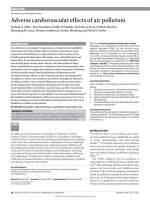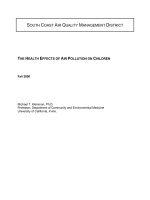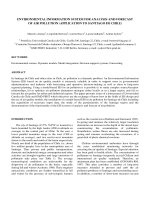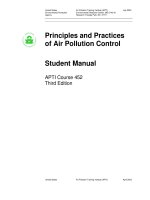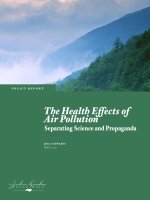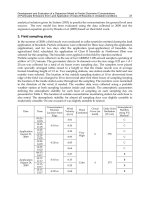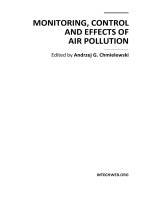Monitoring Control and Effects of Air Pollution Part 5 docx
Bạn đang xem bản rút gọn của tài liệu. Xem và tải ngay bản đầy đủ của tài liệu tại đây (3.45 MB, 20 trang )
Development of Low-Cost Network of Sensors for
Extensive In-Situ and Continuous Atmospheric CO2 Monitoring
71
Cambridge University, UK; Andreas Volz-Thomas of Forschungszentrum, Jülich, Germany;
Jean-Pierre Cammas, CNRS, France; and Charlie Jia-Lin Wang, National Central University,
Taiwan; and T. Machida, NIES, Japan. We thank ECOTECH, Australia, for their
collaborations to upgrade original EC9820 to a version that meet our standards. We thank
Leder Corporation, Taiwan, for their engineering assistance.
6. References
Barkley, M.P.;Monks, P.S.&Engelen, R.J. (2006).Comparisons of SCIAMARCHY and AIRS CO2
measurements over North America during the summer and autumnof 2003, Geophys.
Res. Lett., 33, L20805, doi:10.1029/2006GL026807.
Brumfiel, G. (2009). Satellite to monitor carbon sinks sinks.Nature, doi:10.1038/4571067b.
Chahine, M. et al. (2006). AIRS: Improving weather forecasting and providing new data on
greenhouse gases, Bull. Amer. Meteor. Soc.,87, pp.911-926.
Chen, C.&Xu, Z. (2005).Experiment determination of after-operating gas composition in a
transverse-flow CW high power CO2 laser, Optics Laser Tech.,37, pp.293-297.
Dickerson, R.R.&DelanyA.C. (1988).Modification of a commercial gas filter correlation CO
detector for enhanced sensibility,Atmos,J Oceanic Tech.,5,pp.424-431.
Doddridge, B.G.;Dirmeyer,P.A.;Merrill,J.T.;Oltmas,S.J. &Dickerson, R.R. (1994).Interannual
variability over the eastern North Atlantic Ocean: Chemical and meteorological evidence for
tropical influence on regional-scale transport in the extratropics, Geophys., J.;Res., 99,
No. D11,22,pp.923-935.
Doddridge, B.G. et al. (1998), Gound-based and airborne observations of carbon monoxide during
NASA Measurements of Air Pollution From Satellite (MAPS) missions SRL-1 and SRL-2,
Geophys., J.;Res., 103, No. D15, pp.19,305-19,316.
ECOTECH (2007), EC9820 Carbon Dioxide Analyser Service Manual Revision: B, ECOTECH
environmental monitoring, Australia.
Gerbig, C.;Schmitgen,S.;Kley,D.;Volz-Thomas,A. &Dewey,K. (1999), An improved fast-
response vacuum-UV resonance fluorescence CO instrument, Geophys,J Res., 104, No.
D1, pp.1699-1704.
Haag, A. (2007), The crucial measurement, Nature, pp.785-787.
Hand, E. (2009), Budget win for climate probe, Nature, pp.462, 832.
Heimann, M. (2009), Searching out the sinks, Nature Geoscience, pp.2-4.
Kintisch, E. (2009), Loss of carbon observatory highlights gaps in data, Science, 323, pp.1276-
1277.
Machida, T. et al. (2008), Worldwide measurements of atmospheric CO2 and other trace gas species
using commercial airlines,Atmos,J Oceanic Technol., 25, pp.1744-1754.
Marquis, M.&Tans,P. (2008), Carbon crucible, Science, 320, pp.460-461.
Matsueda, H.&InoueH.Y. (1996), Measurements of atmospheric CO2 and CH4 using a commercial
airliner from 1993 to 1994, Atmos. Environ., 30, pp.1647-1655.
Normile, D. (2009), Tracking CO2’s comings and goings from space, Science,pp.323, 325.
Novelli, P.C. (1999), CO in the atmosphere: measurement techniques and related issues,
Chemosphere: Global Change Sci., 1, pp.115-126.
NRC (2010), Verifying greenhouse gas emissions: Methods to support international climate
agreements, Committee on Methods for Estimating Greenhouse Gas Emissions,
National Research Council, pp.144., The National Academies.
Monitoring, Control and Effects of Air Pollution
72
Parrish, D.D.;Holloway,J.S. &Fehsenfeld, F.C. (1994), Routine, continuous measurement of
carbon monoxide with parts per billion precision, Environ. Sci. Tech., 28, pp.1615-1618.
Tollefson, J.&Brumfiel,G. (2009), Climate researchers in a spin after satellite loss, Nature,
doi:10.1038/news.2009.pp.124.
Tollefson, J. (2010), Greenhouse-gas numbers up in the air, Nature, 465, pp.18-19.
Van der Laan, S.;Neubert,R.E.M. &Meijer,H.A.J. (2009), A single gas chromogratograph for
accurate atmospheric mixing ratio measurements of CO2, CH4, N2O, SF6, and CO,
Atmos. Meas. Tech., 2, pp.549-559.
Volz-Thomas, A. et al. (2007), In-service aircraft for global observations – the future,IGACtivities,
37, pp.18-22.
Watson, A.J. et al. (2009), Tracking the variable North Atlantic sink for atmospheric CO2,
Science, 326, pp.1391-1393.
WDCGC (2007), WMO WDCGC Data Summary, WDCGC No. 31, GAW Data, Vol.iV-
Greenhouse Gases and Other Atmospheric Gases, Japan Meteorological Agency in
co-operation with World Meteorological Organization.
Wong, H.L.A.;Wang,T.;Ding, A.;BlakeD.R. &Nam,J.C. (2007), Impact of Asian continental
outflow on the concentrations of O3, CO, NMHC and halocarbons on Jeju Island, South
Korea during March 2005, Atmos. Environ., 41, pp.2933-2944.
Zellweger, C.;Klausen,H.J.;Steinbacher,M.;Vollmer,M.&Buchmann,B. (2009).Inter-comparison
of four different carbon monoxide measurement techniques and evaluation of the long-term
carbon monoxide time series of Jungfraujoch, Atmos. Chem. Phys., 9, pp.3491-3503.
5
Aerosol Optical Thickness and PM10 Study by
Using a Handheld Spectroradiometer
Over Penang
Tan Fuyi, Lim Hwee San, Mohd. Zubir Mat Jafri and K. Abdullah
School of Physics, Universiti Sains Malaysia,
Malaysia
1. Introduction
Knowledge of the parameters that are related to the optical properties of atmospheric
aerosols is essential for the determination of their climatic effects, development of
techniques for remote sensing of aerosol from space or the necessary correction of
atmospheric effects in satellite imagery (Sanchez, et al., 1998). The AOT values were derived
from the measured transmittance. AOT, τ, is a measure of aerosol loading in the atmosphere
(Christopher, et al., 2002). Generally, a higher AOT value indicates higher column of aerosol
loading and therefore low visibility (Wang and Christopher, 2003).
Atmospheric components (aerosol and molecules) scatter and absorb solar radiation. This
study investigated the use of a handheld spectroradiometer for the retrieval of atmospheric
optical thickness (AOT) values over Penang Island. A set of spectroradiometer measured
transmittance data was used to derive the aerosol optical thickness (AOT) in the
atmosphere. The transmittance values were measured in spectral region from 350nm to
1050nm at the earth surface. The locations were determined with a Global Positioning
System (GPS) receiver. We selected the values at 550nm for the present analysis. This study
introduces an economical and a simple technique for retrieval of AOT for remote sensing
application. The transmittance values were measured around the PenangIsland. Particulate
matters of size less than 10 micron (PM10) were collected simultaneously with the
acquisition of the transmittance measurements. The results of the analysis indicated that the
AOT values were linearly correlated with the PM10 readings.
The objective of this study was to explore the relationship between aerosol optical thickness
(AOT) derived from the spectroradiometer transmittance measurements and the correlation
of particulate matter less than 10 micron (PM10). PM10 values were colleted simultaneously
with the transmittance measurements. This study showed that there was a good correlation
between the derived AOT and the measured PM10. In this study, we present results from
ground-based measurements for PM10 mapping.
Many researchers have conducted satellite monitoring of the AOT [Husar, et al., (1997) and
Liu, et al., (2002), Jiang, et al., (2007) and Guo, et al., (2009)]. In this study, we present a method
for air quality mapping from ground-based measurements. Typically, ground based
measurements were made with a device of sun photometer. In this study, our purpose is to
generate AOT and PM10 maps over Penang Island, Malaysia by using a handheld
spectroradiometer. The transmittance values were measured using a handheld
Monitoring, Control and Effects of Air Pollution
74
spectraradiometer. The sensitivity of this type of spectroradiometer is between the spectral
wavelengths from 350 nm to 1050 nm. The wells know Beer-Lambert law was used in this
study to retrieve AOT values from the transmittance value measurements. AOT and PM10
maps were generated using Kriging interpolation techniquebased on the measured data. This
study indicates that the spectroradiometer is a useful tool for retrieval of AOT and PM 10
values in Penang, Malaysia
2. Study area
The study area is the Penang Island, Malaysia, located within latitudes 5º 9’ N to 5º 33’ N
and longitudes 100º 09’ E to 100º 30’ E. The map of the study area is shown in Figure 1.
Penang Island is located in equatorial region and enjoys a warm equatorial weather the
whole year. Therefore, it is impossible to get the 100 % cloud free satellite image over
Penang Island. But, the satellite image chosen is less than 10 % of cloud coverage over the
study area. Penang Island located on the northwest coast of Peninsular Malaysia.
Fig. 1. The study area
Aerosol Optical Thickness and PM10 Study by
Using a Handheld Spectroradiometer Over Penang
75
Penang is one of the 13 states of the Malaysia and the second smallest state in Malaysia after
Perlis. The state is geographically divided into two different entities - Penang Island (or
“Pulau Pinang” in Malay Language) and a portion of mainland called “SeberangPerai” in
Malay Language. Penang Island is an island of 293 square kilometres located in the Straits of
Malacca and “SeberangPerai” is a narrow hinterland of 753 square kilometres (Tan, et al.,
2010). The island and the mainland are linked by the 13.5 km long Penang Bridge and ferry.
Penang Island is predominantly hilly terrain, the highest point being Western Hill (part of
Penang Hill) at 830 metres above sea level. The terrain consists of coastal plains, hills and
mountains. The coastal plains are narrow, the most extensive of which is in the northeast
which forms a triangular promontory where George Town, the state capital, is situated. The
topography of “SeberangPerai” is mostly flat. Butterworth, the main town in
“SeberangPerai”, lies along the “Perai” River estuary and faces George Town at a distance of
3 km (2 miles) across the channel to the east (Tan, et al., 2010).
The Penang Island climate is tropical, and it is hot and humid throughout the year. with the
average mean daily temperature of about 27ºC and mean daily maximum and minimum
temperature ranging between 31.4ºC and 23.5ºC respectively. However, the individual
extremes are 35.7ºC and 23.5ºC respectively. The mean daily humidity varies between 60.9%
and 96.8%. The average annual rainfall is about 267 cm and can be as high as 624 cm (Tan, et
al., 2010).
3. Data acquisition
The corresponding PM10 measurements were collected at the several selected locations
around the Penang Island between 9.00 a.m. to 3.00 p.m. A handheld spectroradiometer was
used to collect the sky transmittance data over Penang Island, Malaysia campus on 24th
December 2008 from 40 stations in the USM campus (Fig. 2). The AOT was calculated based
on the Beer-Lambert-Bouguer law. Table 1 shows the specification of the ASD handheld
spectroradiometer used in this study.
White
Pistol grip
7.2 v Li-ion
Power cable
White
S
p
ectroradiomet
Fig. 2. TheASD handheld Spectroradiometer
Monitoring, Control and Effects of Air Pollution
76
FieldSpec® HandHeld
(325-1075nm)
A field portable, lightweight, battery powered
spectroradiometer.
Spectral Range:
325 - 1075 nm.
Sampling Interval :
1.6 nm.
Spectral Resolution:
3.5 nm at 700 nm.
Noise Equivalent Delta Radiance
(NeDL):
5.0 x 10^-9 W/cm^2/nm/sr @ 700 nm.
Weight:
1.2 kg including battery pack.
Size:
22 x 16 x 8.2 cm.
Table 1. Specification of the ASD handheld Spectroradiometer
4. Methodology
The transmittance data over PenangIsland on 24th December 2008 was used in this study.
The observation site is located in the northern region of the Peninsular Malaysia. The
spectroradiometer measure the atmospheric transmittance from 350nm to 1050nm. The data
that have been used in this study were collected at 40 locations in Penang, Malaysia.
The AOT is calculated based on the Beer-Lambert-Bouguer law. The AOT is related to the
transmission by the expression
s
u
d
Te
λ
τ
λ
−
= (Vermote, et al., 1997) (1)
where
T
d
λ
= transmittance for direct irradiance at wavelength, λ
u
s
= cosines (θ), θ is the zenith angle
AOT values were obtained after performing the sequence of the following calculations:
1. First, we measured the total solar irradiance. This was done by measuring the radiance
reflected from a Spectralon panel placed perpendicular to the direction of the Sun. The
measured radiance was converted into irradiance by multiplying by П and then
divided by the reflectance of the Spectralon panel.
2. Second, we measured the diffuse irradiance. This step was performed with the same
Spectralon panel maintained in the same orientation as in step 1. The panel was shaded
from direct sunlight using a disk of black painted cardboard mounted on a stick. The
size of the disk and distance to the panel should be such that the shadow of the disk on
the panel is just sufficient to fully shade the area viewed by the FieldSpec HH. As in
step 1, we measured the reflected radiance. Again, the measured radiance is converted
to irradiance by multiplying by П and then dividing by the reflectance of the Spectralon
panel.
3. Third, we computed the direct solar irradiance by subtracting the diffuse irradiance
from the measured total solar irradiance.
Aerosol Optical Thickness and PM10 Study by
Using a Handheld Spectroradiometer Over Penang
77
4. Fourth, we computed the top-of-atmosphere (TOA) solar irradiance values
corresponding to the wavelengths of the spectra measured by the FieldSpec HH. In this
study, Wehrli 1985 AM0 Spectrum was chosen to calculate the TOA spectra and
interpolate it to the FieldSpec HH wavelengths, multiplying by cosines solar angle and
then correct for the exact Earth-Sun distance factor, D, given by Spencer, 1971 as
1.00011 0.034221cos
0.00128sin 0.000719cos2
0.000077sin 2
D
φ
φφ
φ
=+
++
+
(2)
The day angle,
φ
, in radians is represented by
2 ( 1)/365d
φ
π
=− (3)
where d is the day number of a year (1-365)
5.
Finally, we computed the atmospheric transmission by dividing the direct solar
irradiance computed in step 3 by the top of atmosphere values calculated in the fourth
step. This was done by first exporting the FieldSpec HH spectrum to a text file,
importing the text file into a program like MS Excel and then performing the
calculations in Excel. Then the AOT values were computed using Equation (1).
5. Data analysis and results
The transmittance values were measured using a handheld spectraradiometer. The
sensitivity of this type of spectroradiometer is between the spectral wavelengths from 350
nm to 1050 nm. We selected 6 spectral wavelengths in this study centred at 400.5 nm, 500.5
nm, 600.5 nm, 700 nm, 800 nm and 900 nm. These selected 6 bands are based on the Wehrli
1985 AM0 Spectrum. Then the transmittance values were used to derive the AOT values
using Equation (1). AOT maps were created using Kriging interpolation technique for
estimating aerosol values to be associated to their distribution patterns (Figure 3).
In this study, we used PM10 as air quality parameter measurements over Penang Island.
The relationship between AOT and PM10 was investigated in this study and we discovered
that there was a linear relationship between PM10 and AOT. The linear correlation
coefficient (R) was greater than 0.8 (Figure 3). Several studies have indicated linear
relationship between these parameter [Christopher and Wang, (2003) and Wang and
Christopher, (2003)]. We can clearly see from Figure 4 that PM10 values was increasing as
the AOT values increasing. Therefore AOT is a useful information for retrieval of PM 10
values.
From our experimental data set, we can see the PM10 increases as the AOT increases. This
mean that as the AOT values increases these is an increase of the concentration of PM10.
Therefore, we obtained a positive correlation between AOT and PM10. From the AOT and
PM10 maps, we can see that the high concentration of the AOT and PM10 values was
located near the Bayan Lepas and Prai industrial areas (Black circle) and Georgetown urban
areas (Red circle) (Figures 3 and 5). This was due to the high density of population area and
industrial area respectively. The air pollution caused by industry has even more grave
effects than vehicle exhaust fumes
Monitoring, Control and Effects of Air Pollution
78
(a) (b)
(c) (d)
(e) (f)
Fig. 3. AOT map for (a) 400.5 nm, (b) 500.5 nm, (c) 600.5 nm, (d) 700 nm, (e) 800 nm and
(f) 900 nm
Aerosol Optical Thickness and PM10 Study by
Using a Handheld Spectroradiometer Over Penang
79
(a) (b)
(c) (d)
(e) (f)
Fig. 4. A linear correlation between AOT and PM10 (μg/m3) values for (a) 400.5 nm,
(b) 500.5 nm, (c) 600.5 nm, (d) 700 nm, (e) 800 nm and (f) 900 nm
6. Conclusion
AOT retrieval was produced by the handheld spectroradiometer from the atmospheric
transmittance measurements. The results showed that there was a good agreement between
AOT and PM10. The spectroradiometer retrieved AOT data had a good positive correlation
with the PM10 concentration. This indicates that air quality can be retrieved from the
spectroradiometer transmittance measurements. The interpolated AOT map can be used to
discern air quality categories such as good, moderate and unhealthy to a relatively high
Monitoring, Control and Effects of Air Pollution
80
degree of confidence. A linear relationship between PM10 and AOT was found by this
study. Findings can be used to analyze the air pollution levels over Penang Island.
7. Acknowledgements
This project was carried out using the USM short term grants and Science Fund. The authors
gratefully acknowledge the financial support from the RU grant, Relationship Between Heavy
Rain, Flash Floods And Strong Winds In Malaysia, Southeast Asia During Tropical Cyclones,
account number: 1001/PFIZIK/811152. We would like to thank the technical staff who
participated in this project. Thanks are extended to USM for support and encouragement.
Special thanks are extended to Jet Propulsion Laboratory, California Institute of Technology,
USA for providing free online ASTER DEM data used in this study through GDEM WIST url
that follows.
Thanks are extended to USM for support and encouragement.
8. References
Christopher, S. A., Zhang, J., Holben, B. N. and Yang, S. K., 2002, GOES-8 and NOAA-14
AVHRR retrieval of smoke aerosol optical thickness during SCAR-B, int. j. remote
sensing, 23 (22), 4931-4944
Guo, J. P., Zhang, X. Y., Che, H. Z., Gong, S. L., An, X., Cao, C. X., Guang, J., Zhang, H.,
Wang, Y. Q., Zhang, X. C., Xue, M. and Li, X. L., 2009, Correlation between PM
concentrations and aerosol optical depth in eastern China, Atmospheric
Environment, 43(37), p.p. 5876-5886
Husar R. B., M. Prospero and L. Stowe, 1997, Characterization of tropospheric aerosols over
the oceans with the NOAA advanced very high resolution radiometer optical
thickness operational product, Journal Geophysics. Research, 102, 16889-16909
Jiang, X., Liu, Y., Yu, B. and Jiang, M., 2010, Comparison of MISR aerosol optical thickness
with AERONET measurements in Beijing metropolitan area, Remote Sensing of
Environment, 107(1-2), 15, p.p. Pages 45-53
Liu, G. R., Chen, A. J., Lin, T. H. and Kuo, T. H., 2002, Applying SPOT data to estimate the
aerosol optical depth and air quality, Environmental modeling& software, 17, 3-9
Sanchez Oliveros, C., Olmo Reyes, F. J. danAlados-Arboledas, L., 1998, Determination of
aerosol optical thickness from measurements of spectral sky radiance. Journal of
aerosol Science, 10, p.p. 1199-1211
Tan, K. C., Lim, H. S., MatJafri, M. Z. and Abdullah, K., 2010, Landsat data to evaluate urban
expansion and determine land use/land cover changes in Penang Island, Malaysia,
Springer, Environmental Earth Sciences, 60(7), p. p.1509–1521, ISSN: 1866-6280
(Print) 1866-6299 (Online), Available online:
Digital Object
Identifier: 10.1007/s12665-009-0286-z
Vermote, E., Tanre, D., Deuze, J. L., Herman, M. and Morcrette, J. J., 1997, Second Simulation
of the satellite signal in the solar spectrum (6S), [Online] available:
Wang, J. and Christopher, S. A., 2003, Intercomparison between satellite-derived aerosol
optical thickness and PM2.5 mass: Implications for air quality studies, Geophysics
Research Letters, 30 (21)
Wehrli 1985 AM0 Spectrum, [Online] available:
6
Remote Sensing of PM2.5 Over Penang Island
from Satellite Measurements
Sim Chong Keat, Lim Hwee San,
Khiruddin Abdullah and Mohd. Zubir Mat Jafri
School of Physics, Universiti Sains Malaysia,
Malaysia
1. Introduction
Satellite remote sensing technique has provided new datasets for monitoring air quality at
regional and urban area. Air pollution in Asian cities has grown with the progressing
industrialization and urbanization. Air quality standards often refer to respirable suspended
particulate matter (PM), being aerosols with a diameter smaller than 2.5 µm (PM2.5). The
generated algorithm was based on the aerosol optical depth. Remote sensed data provide
comprehensive geospatial information on air quality with both qualitative imagery and
quantitative data, such as particulate matters of size less than 2.5 micron (PM2.5).
Remote sensing has been widely used for environmental application such as for air quality
and water quality studies. But the atmosphere affects satellite images of the Earth’s surface
in the solar spectrum. So, the signal observed by the satellite sensor is the sum of the effects
from the ground and atmosphere. Surface reflectance is a key to the retrieval of atmospheric
components from remotely sensed data. The accuracy of aerosol remote sensing techniques
heavily depends on the information on the ground reflectance (Kokhanovskya, et al., 2005).
Environmental pollution is coeval with the appearance of humans. When Homo sapiens
first lighted fire, its smoke provided the first medium of environmental pollution. The
burning of fuels for heating and cooking has contributed to the air pollution of inner spaces
(Makra and Brimblecombe, 2004). Air pollution is one of the most important environmental
problems, which concentrates mostly in cities. Generally, human activities induce
monotonous accumulation of pollutants [Makra, et al., (2001a) and Makra, et al., (2001b)].
Sources of exposure to particulate air pollution are many, Indoor sources, including
cooking, unvented heating appliances and pets often make important contributions to
exposures. Road traffic, however, generally provides the major source of ambient particulate
pollution (Gulliver and Briggs, 2004).
We used a DustTrak Aerosol Monitor 8520 to collect in situ data. The particulate matters of
size less than 2.5 micron data were collected simultaneously during the satellite Landsat
overpass the study area. An empirical relationship between PM2.5 derived from the SPOT
using regression technique is explored. A new algorithm was developed base on the aerosol
characteristics in the atmosphere. We were obtained the atmospheric reflectance values by
subtracting surface reflectance from the amount of reflectance measured from the satellite. The
satellite recorded reflectance is the sum of the surface reflectance and atmospheric reflectance.
The surface refleatance values were retrieved using ATCOR3 in the PCI Geomatica 10.3 image
Monitoring, Control and Effects of Air Pollution
82
processing software. The atmospheric reflectance values were later used for PM2.5 mapping
using the calibrated algorithm. The efficiency of the developed algorithm, in comparison to
other forms of algorithm, will be investigated in this study. Based on the values of the
correlation coefficient and root-mean-square deviation, the proposed algorithm is considered
superior. It is found that a linear relationship reveal a good results with PM2.5 measurements
where the R value exceeding 0.89. The calibrated algorithm will be used to generate the air
quality maps over Penang Island, Malaysia. The finding obtained by this study indicates that
the SPOT data can be used to retrieved air quality information for remotely sensed data.
2. Remote sensing
Remote sensing is a technique for collecting information about the earth without touching
the surface using sensors placed on a platform at a distance from it. The major applications
of remote sensing include environmental pollution, urban planning, and earth management.
We have to understanding the basic concept of electromagnetic waves well enough to apply
remote sensing techniques in our studies. We classify electromagnetic energy by its
wavelength. This electromagnetic radiation give an energy source to illuminate the target
except the sensed energy is being emitted by the target.
There are two types of remote sensors: active and passive. Passive remote sensors detect
reflected energy from the sun back to the sensor; they do not emit energy itself. But active
sensors can emit energy or provide its own source of energy and detect the reflected energy
back from the target. There are two types of remotely sensed data: airborne and space-
borne. Airborne images are captured using sensors placed on aircraft platform while space-
borne images are captured using sensors placed on a satellite platform. Remotely sensed
data began with the traditional black and white aerial photography and followed by colour
photography. However hyperspectral airborne or space-borne images are readily available
nowadays. We use both the multispectral airborne and space-borne digital images in our
studies. The major advantage of using remote sensing data is that we can produce the final
output as maps of the Earth’s surface phenomena by studies.
3. Study area
The study area is the Penang Island, Malaysia, located within latitudes 5
o
9’ N to 5
o
33’ N
and longitudes 100
o
09’ E to 100
o
30’ E. The map of the study area is shown in Figure 1.
Penang Island is located in equatorial region and enjoys a warm equatorial weather the
whole year. Therefore, it is impossible to get the 100 % cloud free satellite image over
Penang Island. But, the satellite image chosen is less than 10 % of cloud coverage over the
study area. Penang Island located on the northwest coast of Peninsular Malaysia.
Penang is one of the 13 states of the Malaysia and the second smallest state in Malaysia after
Perlis. The state is geographically divided into two different entities - Penang Island (or
“Pulau Pinang” in Malay Language) and a portion of mainland called “Seberang Perai” in
Malay Language. Penang Island is an island of 293 square kilometres located in the Straits of
Malacca and “Seberang Perai” is a narrow hinterland of 753 square kilometres (Tan, et al.,
2010). The island and the mainland are linked by the 13.5 km long Penang Bridge and ferry.
Penang Island is predominantly hilly terrain, the highest point being Western Hill (part of
Penang Hill) at 830 metres above sea level. The terrain consists of coastal plains, hills and
mountains. The coastal plains are narrow, the most extensive of which is in the northeast
which forms a triangular promontory where George Town, the state capital, is situated. The
Remote Sensing of PM2.5 Over Penang Island from Satellite Measurements
83
topography of “Seberang Perai” is mostly flat. Butterworth, the main town in “Seberang
Perai”, lies along the “Perai” River estuary and faces George Town at a distance of 3 km (2
miles) across the channel to the east (Tan, et al., 2010).
The Penang Island climate is tropical, and it is hot and humid throughout the year. with the
average mean daily temperature of about 27ºC and mean daily maximum and minimum
temperature ranging between 31.4ºC and 23.5ºC respectively. However, the individual
extremes are 35.7ºC and 23.5ºC respectively. The mean daily humidity varies between 60.9%
and 96.8%. The average annual rainfall is about 267 cm and can be as high as 624 cm (Tan, et
al., 2010).
Fig. 1. The study area
Monitoring, Control and Effects of Air Pollution
84
4. Algorithm model
The atmospheric reflectance due to molecule, R
r
, is given by (Liu, et al., 1996)
Θ
rr
r
sv
τ P( )
R=
4μμ
(1)
where
τ
r
= Rayleigh optical thickness
P
r
( Θ ) = Rayleigh scattering phase function
µ
v
= Cosine of viewing angle
µ
s
= Cosine of solar zenith angle
We assume that the atmospheric reflectance due to particle, Ra, is also linear with the τa
[King, et al., (1999) and Fukushima, et al., (2000)]. This assumption is valid because Liu, et
al., (1996) also found the linear relationship between both aerosol and molecule scattering.
()
4
Θ
=
aa
a
sv
P
R
τ
μμ
(2)
where
τ
a
= Aerosol optical thickness
P
a
( Θ ) = Aerosol scattering phase function
Atmospheric reflectance is the sum of the particle reflectance and molecule reflectance, R
atm
,
(Vermote, et al., (1997).
atm a r
R= R+R (3)
where
R
atm
= atmospheric reflectance
R
a
= particle reflectance
R
r
= molecule reflectance
() ()
44
1
() ()
4
aa rr
atm
sv sv
atm a a r r
sv
PP
R
RPP
ττ
μμ μμ
ττ
μμ
⎡⎤
ΘΘ
=+
⎢⎥
⎣⎦
=Θ+Θ
⎡
⎤
⎣
⎦
(4)
The optical depth is given by Camagni and Sandroni, (1983), as in equation (5). From the
equation, we rewrite the optical depth for particle and molecule as equation (6)
= s
τσ
ρ
(5)
where
τ = optical depth
σ = absorption
s = finite path
=+
ar
ττ τ
(Camagni and Sandroni, 1983)
Remote Sensing of PM2.5 Over Penang Island from Satellite Measurements
85
=
rrr
s
τσ
ρ
(6a)
=
p
pp
s
τσ
ρ
(6b)
Equations (6) are substituted into equation (4). The result was extended to a three bands
algorithm as equation (7) Form the equation; we found that PM was linearly related to the
reflectance for band 1 and band 2. This algorithm was generated based on the linear
relationship between
τ and reflectance. Retalis et al., (2003), also found that PM was linearly
related to
τ and the correlation coefficient for linear was better that exponential in their
study (overall). This means that reflectance was linear with PM. In order to simplify the data
processing, the air quality concentration was used in our analysis instead of using density,
ρ,
values.
1
() ()
4
=Θ+Θ
⎡
⎤
⎣
⎦
atm a a a r r r
sv
RsPsP
σρ σρ
μμ
() ()
4
=Θ+Θ
⎡
⎤
⎣
⎦
atm a a a r r r
sv
s
RPP
σρ σρ
μμ
11111
() () (,) () (,)
4
=Θ+Θ
⎡
⎤
⎣
⎦
atm a a r r
sv
s
RPPGP
λσλλσλλ
μμ
22222
() () (,) () (,)
4
=Θ+Θ
⎡
⎤
⎣
⎦
atm a a r r
sv
s
RPPGP
λσλλσλλ
μμ
0112
() ()=+
atm atm
PaR aR
λλ
(7)
where
P = Particle concentration (PM2.5)
G = Molecule concentration
R
atm
= Atmospheric reflectance, i = 1 and 2 are the band number
a
j
= algorithm coefficients, j = 0, 1, 2, … are then empirically determined.
5. Data analysis and results
Remote sensing satellite detectors exhibit linear response to incoming radiance, whether
from the Earth’s surface radiance or internal calibration sources. This response is
quantized into 8-bit values that represent brightness values commonly called Digital
Numbers (DN). To convert the calibrated digital numbers to at-aperture radiance,
rescaling gains and biases are created from the known dynamic range limits of the
instrument.
The satellite image was rectified using the second order polynomial coordinated
transformation using nearest neighbor method to relate ground control points (GCP) in the
map to their equivalent row and column positions in the TM scene. Overall, both satellite
images achieved the RMS errors less than 0.5 pixels in this study (Vicente-Serrano et al.
2008; Schroeder et al. 2006; Kabbara et al. 2008).
Monitoring, Control and Effects of Air Pollution
86
The digital numbers (DN values) corresponding to the ground truth sample locations were
extracted from all the images. The DN for window size of 3 by 3 was used because the data
set produced higher correlation coefficient and lower RMS value. The DN values were
converted into radiance values and later reflectance values.
It should be noted that the relfectance values at the top of atmospheric is the sum of the
surface reflectance and atmospheric relfectance. The signals measured in each of these
visible bands represent a combination of surface and atmospheric effects, usually in
different proportions depending on the condition of the atmosphere. Therefore, it is
required to determine the surface contribution from the total reflectance received at the
sensor. In this study, we extracted the surface reflectance from mid-infrared band because
the surface reflectances at various bands across the solar spectrum are correlated to each
other to some extended. The surface reflectances of dark targets in the blue and red bands
were estimated using the measurements in the mid-infrared band (Quaidrari and Vermote,
1999). Over a simple black target, the observed atmospheric reflectance, is the sum of
reflectance of aerosols and Rayleigh contributions (Equation 8). This simplification,
however, is not valid at short wavelengths (less than 0.45 pm) or large sun and view zenith
angles (Vermote and Roger, 1996). In this study, a simple form of the equation was used in
this study (Equation 9). This equation also used by other research in their study (Poop,
2004).
Rs – TRr = Ratm (8)
Rs – Rr Ratm
= (9)
where:
Rs = reflectance recorded by satellite sensor
Rr = reflectance from surface references
Ratm = reflectance from atmospheric components (aerosols and molecules)
T = transmittance
It should be noted that the relfectance values at the top of atmospheric was the sum of the
surface reflectance and atmosphere relfectance. In this study, we used ATCOR3 image
correction software in the PCI Geomatica 10.3 image processing software for creating a
surface reflectance image. Usually, the absolute radiometric correction methods available
only correct for atmospheric effects of satellite imagery (Janzen et al. 2006). Therefore, they
may suitable in certain atmospheric correction in flat or terrain area. But, the algorithm
proposed cannot reduce the topographic effects. Hence, in mountainous terrain, these
methods may bring some errors while apply the algorithms to eliminate the atmospheric
effects (Tan, et al., 2010).
In order to remove atmospheric and topographic effects efficiently, a method has been
developed and implement in satellite imagery over mountainous area. The algorithm
proposed is based on the Richter model (Richter 1990). The algorithm generates the three-
dimensional atmosphere by considering the transmittance and radiance functions of
different height, included atmospheric conditions alteration in horizontally. Consequently, it
is able to solve the problem of haze through the statistical algorithm, which helps to
manipulate the optical depths in different altitude.
ATCOR3 is a new approach implemented in PCI Geomatica 10.3 image processing software
and the technique based on the ATCOR2 model. But ATCOR2 model restricted for a flat
Remote Sensing of PM2.5 Over Penang Island from Satellite Measurements
87
terrain to calculate surface reflectance. Both of these models have the similarity, where the
approaches apply the technique from dense dark vegetation approach (Liang et al. 1997)
and the modified dense dark vegetation approach (Song et al. 2001).
A database contains radiative transfer code is acquired from the calculation of direct and
diffuse solar flux, path radiance and atmospheric transmittance with the wide range of
weather conditions, in terms of atmospheric conditions (Richter 1998). Beside, ATCOR3
requires the information, such as slope, orientation and surface elevation, to eliminate the
topographic effects. The range cover the mountainous terrain should not greater than 3.5 km
above the sea level. Furthermore, if ATCOR3 apply to the area involved rugged terrain, the
algorithm need to calculate the specified atmospheric conditions based on Lambertian
assumption. Overall, the method implemented here only restricted to high spatial resolution
satellite sensors with small swath angle like Landsat and Systeme pour I’Observation de la
Terre (SPOT).
The advantage of ATCOR3 is the module can generate a surface reflectance map using
reference elevation data. In addition, retrieval of surface reflectance thematic map becomes
more accurate, especially in high mountain terrain, because it considers the slope and aspect
images. In this study, the reference DEM model known as ASTER Global Digital Elevation
Map (GDEM) was used to retrieve the a surface reflectance values (Fig 2). And then the
reflectance measured from the satellite [reflectance at the top of atmospheric,
ρ(TOA)] was
subtracted by the amount given by the surface reflectance to obtain the atmospheric
reflectance.
Fig. 2. GDEM data used in this study.
Monitoring, Control and Effects of Air Pollution
88
SPOT satellite data was selected corresponding to the ground truth measurements of the
pollution levels (Fig. 3). The satellite image was acquired on 30 January 2005. The
corresponding PM2.5 measurements were collected simultaneously during the satellite
overpass. And then the atmospheric reflectance was related to the PM10 using the
regression algorithm analysis.
Fig. 3. Raw satellite image.
Remote Sensing of PM2.5 Over Penang Island from Satellite Measurements
89
In this study, SPOT signals were used as independent variables in our calibration regression
analysis. A good result was produced by the proposed model, which achieved the
correlation coefficient of about 0.89. The PM10 map was generated using the proposed
algorithm (Figure 4).
Fig. 4. Map of PM2.5 around Penang Island, Malaysia [Blue < 40 ug/m3, Green = (40-80)
ug/m3, Yellow = (80-120) ug/m3, Orange = (120-160) ug/m3, Red = (>160) ug/m3) and
Black = Water]
Monitoring, Control and Effects of Air Pollution
90
6. Conclusion
The result produce by this study indicated the used of SPOT satellite image for PM2.5
mapping over Penang Island. A good agreement was found in this study between PM2.5
measured by the DustTrak Aerosol Monitor 8520 and PM2.5 estimated using the newly
proposed developed algorithm. The developed algorithm produced high R and low RMS
values. This study indicates that satellite observation can be used for air quality mapping
using SPOT data. The use of remotely sensed data produced better spatial resolution air
quality map compared to the spacing between ground stations. Further study will be carried
out to verify the results and a multi regression algorithm will be developed and used in the
analysis.
7. Acknowledgements
This project was carried out using the USM short term grants and Science Fund. The authors
gratefully acknowledge the financial support from the RU grant, Relationship Between
Heavy Rain, Flash Floods And Strong Winds In Malaysia, Southeast Asia During Tropical
Cyclones, account number: 1001/PFIZIK/811152. We would like to thank the technical staff
who participated in this project. Thanks are extended to USM for support and
encouragement. Special thanks are extended to Jet Propulsion Laboratory, California
Institute of Technology, USA for providing free online ASTER DEM data used in this study
through GDEM WIST url that follows. />bin/api/ims.cgi?mode=MAINSRCH&JS=1. Thanks are extended to USM for support and
encouragement.
8. References
Camagni. P. & Sandroni, S. (1983). Optical Remote sensing of air pollution, Joint Research
Centre, Ispra, Italy, Elsevier Science Publishing Company Inc
Fukushima, H.; Toratani, M.; Yamamiya, S. & Mitomi, Y. (2000). Atmospheric correction
algorithm for ADEOS/OCTS acean color data: performance comparison based on
ship and buoy measurements. Adv. Space Res, Vol. 25, No. 5, 1015-1024
Gulliver, J. and Briggs, D. J. 2004. Personal exposure to particulate air pollution in transport
microenvironments. Atmospheric Environment, 38:1-8.
Janzen DT, Fredeen AL, Wheate RD (2006) Radiometric correction techniques and accuracy
assessment for Landsat TM data in remote forested regions. Can J Remote Sens
32(5):330–34
Kabbara N, Benkhelil J, Awad M, Barale V (2008) Monitoring water quality in the coastal
area of Tripoli (Lebanon) using high- resolution satellite data. ISPRS J Photogramm
Remote Sens 63(5):488–495
Kokhanovskya,b, A.A., Mayer, B. and Rozanov, V. V., 2005, A parameterization of the
diffuse transmittance and reflectance for aerosol remote sensing problems,
Atmospheric Research 73, 37 – 43
Liang S, Fallah-Adl H, Kalluri S, Jaja J, Kaufman YG, Townshend JRG (1997) An operational
atmospheric correction algorithm for Landsat Thematic Mapper imagery over the
land. Journal of Geophysical Research, 102:173-186King, M. D.; Kaufman, Y. J.;
Tanre, D. & Nakajima, T. (1999). Remote sensing of tropospheric aerosold form



